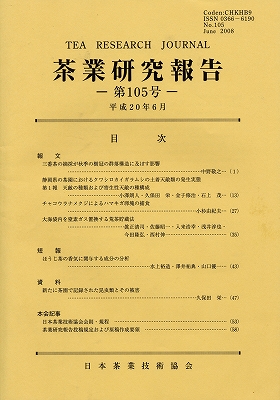
- Issue 126 Pages 1-
- Issue 125 Pages 1-
- |<
- <
- 1
- >
- >|
-
Hideki Horie2018Volume 2018Issue 126 Pages 1-8
Published: December 31, 2018
Released on J-STAGE: January 01, 2021
JOURNAL FREE ACCESSThe demand for matcha is growing. This review includes the relationship between quality and components of matcha, researches on foaming and particle sizes, and current state of studies on the health benefits of matcha.
View full abstractDownload PDF (1235K)
-
Yuzo Mizukami2018Volume 2018Issue 126 Pages 9-15
Published: December 31, 2018
Released on J-STAGE: January 01, 2021
JOURNAL FREE ACCESSThe odorants contributing to the characteristic aroma of sencha produced in the mountainous area have been investigated by using an aroma extract dilution analysis (AEDA) of the volatile fractions isolated from the sencha infusion by comparing that produced at the flat land. Principal component analysis of the flavor dilution factors of all the detected odorants in the AEDA has revealed that furaneol, (Z)-methyl jasmonate, indole and vanillin were the characteristic odorants of the sencha produced in the mountainous area. Since these odorants were also included in the infusion of sencha produced at the flat land, the characteristic aroma of sencha produced in the mountainous area would be affected by the odorants compositions. The experimental result in this study have been obtained by using limited samples. It would be necessary to analyze more samples, to clarify the aroma of sencha produced in the mountainous area.
View full abstractDownload PDF (2352K)
-
Katsutoshi Nishino, Nakao Kubo, Koji Fukunaga, Nobuhiro Hirai2018Volume 2018Issue 126 Pages 17-23
Published: December 31, 2018
Released on J-STAGE: January 01, 2021
JOURNAL FREE ACCESSAluminum ions, which generally suppress root elongation of plants, are important for the growth of tea plants. We analyzed the concentrations of aluminum complexes in tea leaves and soils from the ‘Yabukita’, ‘Benifuki’ and ‘Benihomare’ tea plantations using 27Al NMR spectrometry. The monthly changes in concentrations of aluminum ions were also examined using local varieties of tea leaves from Kyoto and soils in which the tea plants grow. The complexes (oxalato) aluminate and (citrato) aluminate, Al (SO4)+, and aluminum ions were detected in most samples. Their concentrations in the leaves and soils varied among cultivars and sampling times.
View full abstractDownload PDF (1179K)
-
Koji Sasaki2018Volume 2018Issue 126 Pages 25-36
Published: December 31, 2018
Released on J-STAGE: January 01, 2021
JOURNAL FREE ACCESS -
Takayoshi Sakamoto, Keizou Masuda2018Volume 2018Issue 126 Pages 37-39
Published: December 31, 2018
Released on J-STAGE: January 01, 2021
JOURNAL FREE ACCESSThe government of Japan, in the early Meiji era, established Chinese Black Tea Training Centers in several places, in order to promote the export of black tea by leveraging native tea (Yamacha). One of them, the Chinese Black Tea Training Center in Hitoyoshi was established in 1876 (Meiji 9). According to a document, it was located, in Tamachi, Hitoyoshi. A map of Tamachi between the late Meiji and the Taisho era revealed that the Chinese Black Tea Training Center had been near the Juhuku Brewery of today.
View full abstractDownload PDF (1220K) -
2018Volume 2018Issue 126 Pages 41-46
Published: December 31, 2018
Released on J-STAGE: January 01, 2021
JOURNAL FREE ACCESSDownload PDF (1076K)
- |<
- <
- 1
- >
- >|